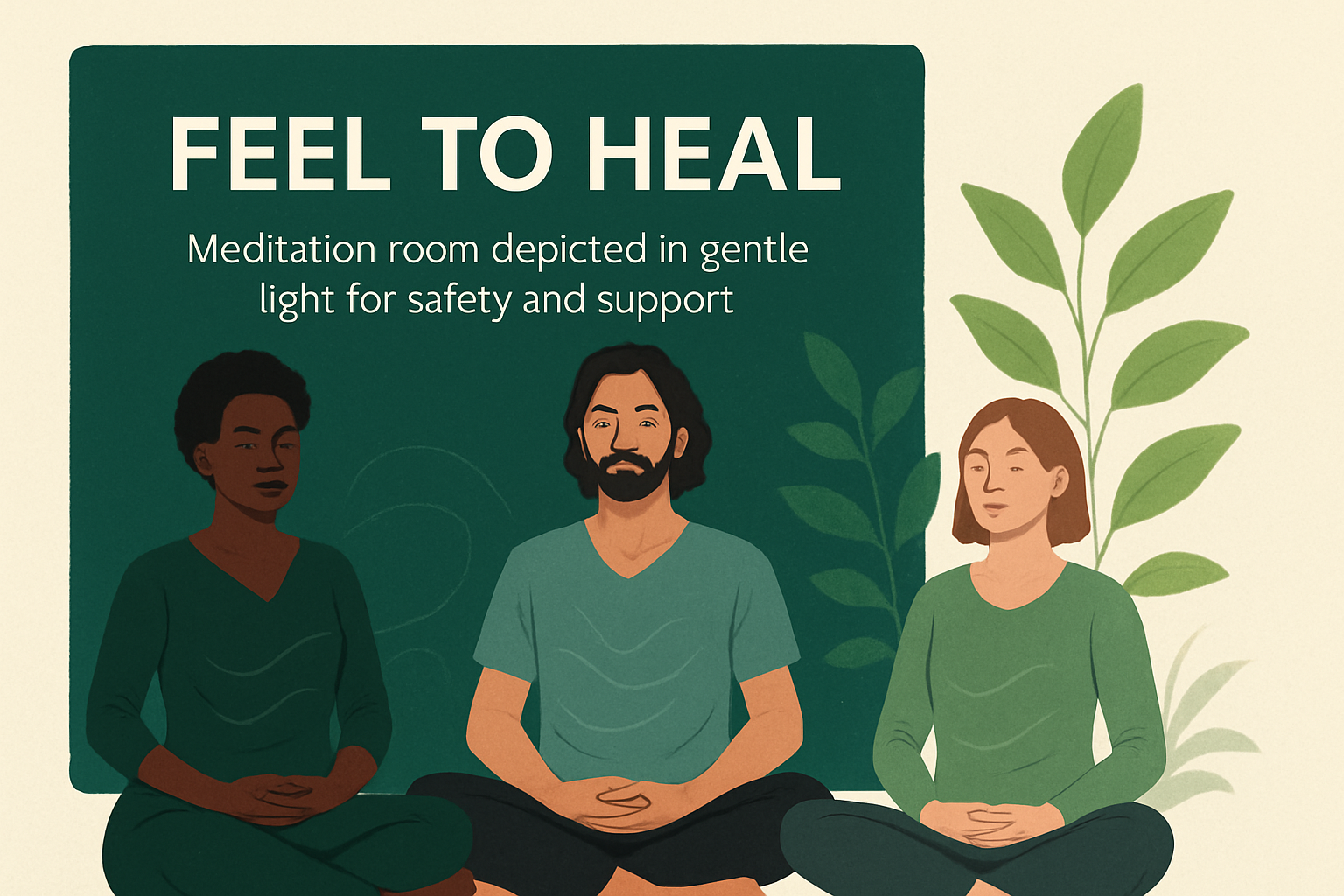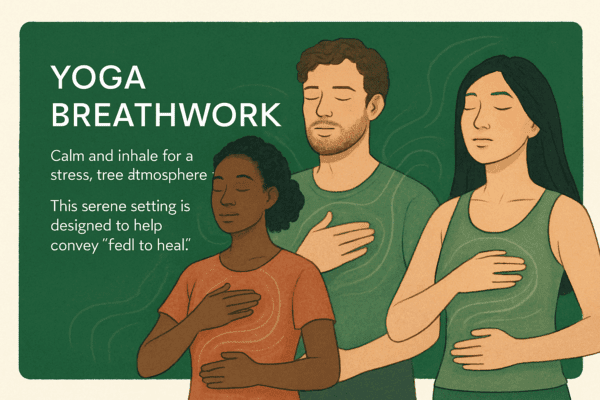Trauma awareness is rising worldwide, and so is the understanding that true healing often requires more than time alone. Meditation has become a powerful ally for those seeking to soothe their minds and bodies after trauma.
In 2025, experts are turning to meditation for trauma as a key practice—backed by research and real-life success stories. This article reveals the 7 best practices to make meditation both safe and effective for trauma recovery.
Ready to discover actionable strategies and the latest science? Let’s explore how meditation can help you reclaim calm, resilience, and hope.
Understanding Trauma and Meditation
Trauma is a complex and deeply personal experience, affecting millions across the globe. As we explore meditation for trauma, it’s important to first understand what trauma is, how it impacts the mind and body, and why meditation has become a vital tool in recovery. Let’s break down the science, challenges, and emerging trends shaping meditation for trauma in 2025.

What is Trauma?
Trauma refers to psychological or emotional responses to deeply distressing events. It can be acute (one-time events), chronic (repeated exposure), or complex (multiple, layered experiences over time). These experiences often leave a lasting imprint on both the mind and body.
According to “The Body Keeps the Score” by Dr. Bessel van der Kolk, trauma reprograms how our nervous system responds to stress. It can lead to anxiety, hypervigilance, and dissociation. Studies estimate that up to 70% of adults worldwide will experience at least one traumatic event, with many facing long-term emotional and physical consequences.
Understanding these effects is crucial when considering meditation for trauma, as it informs how we approach healing practices.
How Meditation Supports Trauma Recovery
Meditation for trauma works by calming the nervous system and creating a sense of safety. Scientific research shows that meditation activates brain regions involved in self-awareness and emotion regulation. This helps counter the overactive stress response—commonly known as “fight-or-flight”—that trauma can trigger.
One meta-analysis found that meditation and yoga significantly reduce PTSD symptoms, providing hope and practical tools for survivors. The practice encourages gentle observation of thoughts and sensations, supporting gradual healing. For more on the evidence behind these benefits, see this Meditation and Yoga for PTSD Meta-Analysis.
As we explore meditation for trauma, knowing the science empowers us to use these tools safely and effectively.
Challenges of Meditating with Trauma
While meditation for trauma can be transformative, it is not always easy. Many trauma survivors encounter difficulties such as flashbacks, dissociation, or intense discomfort when they close their eyes or sit in stillness. Sometimes, traditional meditation practices may unintentionally trigger painful memories or emotions.
For example, survivors have reported feeling overwhelmed or “stuck” when guided to focus inward without proper support. This highlights the importance of trauma-informed approaches that emphasize flexibility and emotional safety. By acknowledging these challenges, we pave the way for more compassionate meditation for trauma.
Evolving Meditation Practices in 2025
The landscape of meditation for trauma is rapidly evolving. In 2025, we’re seeing a surge in trauma-sensitive meditation styles that prioritize safety and personalization. Technology is playing a growing role, with mental health apps and guided meditations tailored for trauma recovery.
Guidelines are being updated to reflect evidence-based practices, ensuring that meditation for trauma is both accessible and effective. The integration of biofeedback, virtual reality, and adaptive routines helps individuals find what works best for their unique needs.
By embracing these innovations, meditation for trauma continues to become more inclusive, supportive, and attuned to the realities of trauma recovery.
Preparing for Meditation: Creating Safety and Support
Preparing for meditation for trauma goes far beyond simply sitting in silence. For trauma survivors, feeling safe—both physically and emotionally—is the foundation for any meaningful healing to begin. Let’s explore how to create a supportive environment, seek the right kind of guidance, build a network, and utilize specialized resources for your journey.

The Importance of a Safe Environment
Safety is the cornerstone of meditation for trauma. Without it, vulnerable emotions may surface too suddenly, making healing difficult or even retraumatizing. Start by choosing a space where you feel secure—this might be a quiet room, a cozy corner, or even a familiar spot outdoors.
Make your space calming by adding soft lighting, soothing scents, or comforting blankets. Consider using gentle background sounds or music if silence feels unsettling. Trauma therapists often recommend having grounding objects nearby, such as a weighted blanket or a favorite item, to help anchor you during practice.
Above all, listen to your body’s cues. If a certain space or setup feels off, adjust it until you find what works best for your meditation for trauma.
Seeking Professional Guidance
Working with a trauma-informed meditation teacher or therapist can be transformative. These professionals understand the unique needs that come with meditation for trauma and can help tailor practices to your comfort level.
Self-guided meditation sometimes brings up unexpected emotions or memories. Without the right support, this can feel overwhelming. If you notice intense discomfort, dissociation, or recurring flashbacks, it’s a sign to pause and seek professional help.
A qualified guide helps you set healthy boundaries, teaches adaptive techniques, and provides reassurance if challenges arise. Remember, investing in expert support is an act of self-care and can make meditation for trauma a gentler journey.
Integrating Support Systems
Healing is rarely a solo process. Surrounding yourself with supportive friends, family, or peer groups can make meditation for trauma more manageable and less isolating. Even just knowing someone is available if you need to talk can be a powerful anchor.
Group meditation sessions—whether in person or online—offer a sense of connection and shared understanding. Research shows that social support can significantly enhance recovery outcomes for trauma survivors.
Reach out to others who understand your journey. Joining a trauma-informed meditation group or connecting with a community can provide encouragement, accountability, and new perspectives as you navigate meditation for trauma.
Tools and Resources for Trauma-Informed Meditation
There are many resources designed specifically for meditation for trauma. Look for apps that offer guided sessions, emergency grounding tools, and trauma-sensitive instructions. Books and online courses can also provide helpful frameworks and exercises.
When selecting resources, focus on those that highlight the interconnectedness of breath, body, and emotions—a concept explored in Breath, Body, Energy, and Emotions. User testimonials and expert endorsements are valuable for finding trustworthy options.
Experiment with different tools until you discover what resonates with you. Having the right resources at your fingertips can make meditation for trauma feel safer and more accessible.
7 Best Practices For Meditation For Trauma In 2025
Approaching meditation for trauma in 2025 requires a blend of innovation and compassion. As research and technology evolve, so do the most effective strategies for healing. Below are the seven best practices, each grounded in the latest science and real-world experience, to help you or your clients safely and meaningfully engage with meditation for trauma recovery.

1. Start with Grounding Techniques
Grounding is the bedrock of meditation for trauma. For many survivors, simply sitting still can trigger anxiety or flashbacks. Grounding techniques help anchor the mind to the present, creating a sense of safety essential for meditation for trauma.
Popular grounding exercises include:
- Body scan: Slowly bring attention to each part of your body, noticing sensations without judgment.
- 5-4-3-2-1 technique: Name five things you can see, four you can touch, three you can hear, two you can smell, and one you can taste.
- Feet on the floor: Press your feet firmly into the ground and notice the support beneath you.
Case studies show that individuals who start meditation for trauma recovery with grounding report less anxiety and greater confidence during sessions. For example, one trauma survivor found that using a body scan before meditation reduced her panic attacks.
Competitors in the trauma recovery space often recommend beginning with grounding-based activities. This advice is echoed by trauma therapists who note that grounding builds a strong foundation for deeper meditation for trauma and helps manage overwhelming sensations.
To maximize benefits, experiment with different grounding techniques until you discover what feels most stabilizing. Remember, grounding is not just an entry step—it can be returned to anytime discomfort arises.
2. Practice Mindful Awareness, Not Avoidance
A core principle of meditation for trauma is mindful awareness. This involves gently noticing thoughts, emotions, and body sensations as they arise, rather than pushing them away or trying to avoid them.
Mindful observation is different from avoidance. Avoidance can reinforce trauma patterns by signaling that certain feelings or memories are dangerous. Mindful awareness, on the other hand, helps you “befriend” your inner experience, as supported by neuroscience research.
Try this mindful awareness exercise:
- Sit comfortably and close your eyes.
- Notice your breath, then shift attention to sensations in your body.
- When discomfort or strong emotions arise, acknowledge them: “I notice tension in my chest.”
- Allow the feeling to be present without trying to change it.
- If you become overwhelmed, return to your breath or open your eyes.
Managing discomfort is crucial. If you notice rising anxiety, remind yourself that it’s normal, and take breaks as needed. Mindful awareness in meditation for trauma is a skill that grows over time, increasing emotional resilience and self-understanding.
Tips for success:
- Start with shorter sessions (5–10 minutes).
- Use gentle curiosity rather than criticism.
- Celebrate small moments of presence.
Practicing mindful awareness, not avoidance, lays the groundwork for deeper healing and empowers you to face trauma-related emotions with confidence.
3. Use Trauma-Sensitive Guided Meditations
Trauma-sensitive guided meditations are designed specifically for those healing from trauma. These practices differ from generic meditation by emphasizing choice, safety, and flexibility, which are essential in meditation for trauma.
Key features of trauma-sensitive guided meditations include:
- Invitations rather than directives (“If you’d like, notice your breath…”)
- Frequent reminders to open your eyes or pause as needed
- Gentle language that avoids triggering imagery
Popular resources for trauma-informed scripts are available through mental health apps and online platforms. These guided sessions often include grounding, body awareness, and self-compassion components. Many survivors report feeling more supported and less alone when using guided meditations tailored for trauma recovery.
Examples of trauma-sensitive meditation resources:
- Insight Timer’s trauma-informed tracks
- Apps with trauma-specific playlists
- Meditations led by certified trauma professionals
Feedback from users highlights that trauma-sensitive guidance makes meditation for trauma more accessible and less intimidating. It allows individuals to move at their own pace and fosters a sense of agency.
If traditional meditation feels overwhelming, guided sessions can provide a safe structure. Over time, you may find yourself more willing to engage with your inner world, knowing you have supportive tools at your fingertips.
4. Incorporate Breathwork and Somatic Practices
Breathwork and somatic practices are powerful tools in meditation for trauma. Trauma often disconnects people from their bodies, making it hard to feel safe “inside.” Breathwork helps regulate the nervous system, while somatic practices foster a sense of embodiment.
Breathwork techniques for trauma include:
- Box breathing: Inhale for four counts, hold for four, exhale for four, hold for four.
- Extended exhale: Breathe in for four counts, out for six or eight.
- Hand-on-heart breathing: Place your hand on your chest and notice the rise and fall.
Somatic practices can also include gentle movement, such as swaying, or using sound (like humming) to create vibration in the body. These practices reconnect you to physical sensations and anchor you in the present.
Research shows that breathwork can significantly reduce PTSD symptoms and support emotional regulation. For a deeper dive into how breathwork and meditation facilitate emotional healing from trauma, explore Healing Emotional Wounds Through Breathwork.
Sample breathwork exercise:
- Sit or lie down comfortably.
- Inhale deeply through your nose, feeling your belly expand.
- Exhale slowly through your mouth, letting tension melt away.
- Repeat for several rounds, noticing any shifts in sensation.
Integrating breathwork and somatic practices into meditation for trauma creates a safe, embodied foundation for healing. It’s a gentle path back to feeling at home in your own body.
5. Set Realistic Expectations and Practice Self-Compassion
Healing is never linear, especially when it comes to meditation for trauma. Setting realistic expectations and practicing self-compassion are vital for long-term recovery.
It’s common to encounter setbacks. Maybe your mind races, or emotions surface unexpectedly. Rather than seeing this as failure, recognize it as part of the healing journey. Self-compassion helps you respond kindly to yourself, even when things feel tough.
Strategies for cultivating self-compassion during meditation for trauma:
- Use affirmations: “It’s okay to feel this way.”
- Reflect on progress, not perfection.
- Journal about your experiences, noting small victories.
Experts recommend starting with short meditation sessions (even 2–5 minutes) and gradually increasing duration as comfort grows. If you miss a day or have a difficult session, simply begin again without judgment.
Common setbacks and how to address them:
- Feeling overwhelmed? Take a break and return when ready.
- Experiencing self-criticism? Remind yourself that healing takes time.
- Struggling to focus? Try a different meditation style or seek support.
Self-compassion has a profound impact on trauma recovery. It builds resilience and encourages you to stay engaged with meditation for trauma, even during challenging times.
6. Create a Flexible, Personalized Meditation Routine
One size does not fit all in meditation for trauma. Flexibility and personalization are key to sustaining a healing practice.
Adapt your meditation routine to fit your needs:
- Experiment with different styles: mindfulness, visualization, movement, or sound-based meditation.
- Adjust session length and frequency based on your daily energy and mood.
- Track emotional responses in a journal to notice patterns and triggers.
Stories from trauma survivors illustrate how finding a unique meditation for trauma approach can make all the difference. For example, some find walking meditation more grounding, while others prefer guided visualization.
A table to help explore options:
| Modality | Description | Best For |
|---|---|---|
| Mindfulness | Focus on present | Calming the mind |
| Visualization | Imagery & safe space | Reframing experience |
| Movement | Gentle body motion | Releasing tension |
| Sound | Humming, music | Sensory grounding |
Competitors in trauma recovery recommend trying multiple modalities and adjusting as your needs change. This adaptable approach helps meditation for trauma become a supportive, rather than stressful, part of your routine.
Remember, flexibility is a strength. Modify your practice as needed, and honor what feels right for you each day.
7. Balance Meditation with Other Trauma Recovery Supports
Meditation for trauma is a powerful tool, but it’s most effective when combined with other supports. Relying solely on meditation may not address all aspects of trauma recovery.
Integrate meditation with:
- Therapy (cognitive, somatic, EMDR)
- Medical care (if needed)
- Social support (friends, family, peer groups)
- Bodywork (massage, acupuncture)
Examples of integration:
- Use meditation for trauma as a grounding tool before or after therapy sessions.
- Pair breathwork with physical therapies to enhance body awareness.
- Engage in group meditation to foster connection and reduce isolation.
Statistics show that combined treatment approaches yield better outcomes for trauma survivors. For instance, those who blend meditation for trauma with psychotherapy often experience faster and more sustainable progress.
Resources for finding trauma-informed professionals include online directories, mental health apps, and local support groups. Don’t hesitate to reach out for help—collaborative care creates a safety net for healing.
Balancing meditation with other trauma recovery supports ensures you receive comprehensive, holistic care. Healing is a team effort, and you deserve all the support available.
Addressing Common Obstacles in Trauma-Focused Meditation
Navigating the journey of meditation for trauma can be challenging, but knowing what to expect makes the path gentler. Below, we break down four common obstacles and offer practical solutions to help you stay supported, resilient, and empowered as you heal.

Dealing with Flashbacks and Emotional Triggers
Flashbacks and emotional triggers can arise unexpectedly during meditation for trauma, causing distress or pulling you out of the present moment. Recognizing early signs—like racing thoughts, tightness in the chest, or feeling suddenly unsafe—can help you respond with care.
If this happens, gently ground yourself. Try focusing on your breath, feeling your feet on the floor, or naming five things you see around you. Techniques like conscious breathing for emotional pain can anchor you and bring a sense of safety when triggers surface.
Remember, it’s okay to pause or modify your meditation for trauma. Prioritize comfort, and return only when you feel ready.
Navigating Discomfort and Resistance
It’s common to experience discomfort or internal resistance during meditation for trauma. Uncomfortable sensations, restless energy, or even a desire to quit are normal responses as your mind and body process old wounds.
Instead of forcing yourself to push through, try these approaches:
- Shorten your practice time.
- Switch to a different meditation style, like movement or sound.
- Use gentle self-talk to acknowledge your feelings.
Allowing space for resistance often leads to greater self-understanding. Taking breaks and coming back later is a sign of self-respect, not failure, in meditation for trauma.
Recognizing When to Pause or Seek Help
While meditation for trauma is a valuable tool, there are times when it’s best to pause and seek professional support. Warning signs include feeling more anxious after sessions, experiencing frequent dissociation, or having thoughts of self-harm.
If you notice these red flags, reach out to a trauma-informed therapist or counselor. They can help you adjust your meditation for trauma and ensure your healing journey remains safe.
Listening to your body’s signals is an act of self-care. Professional guidance can make all the difference in creating a sustainable practice.
Building Resilience Through Consistency
Consistency is key to building resilience with meditation for trauma. Gentle, regular practice—even just a few minutes a day—can foster a sense of safety and progress over time.
Research shows that mindfulness meditation reduces emotional pain and supports healing for trauma survivors. For inspiration, you can read about how mindfulness meditation reduces emotional pain in real-world studies.
Track your growth by journaling or celebrating small milestones. Each step forward, no matter how small, is a victory in your trauma recovery journey.
The Future of Meditation for Trauma Recovery
The landscape of meditation for trauma is rapidly evolving, shaped by innovation, science, and community engagement. As we look to 2025 and beyond, practitioners and survivors alike can anticipate a future that is more personalized, accessible, and holistic than ever before.
Innovations in Trauma-Informed Meditation (2025 and Beyond)
New technologies are redefining meditation for trauma, making healing more immersive and accessible. Artificial intelligence now personalizes guided sessions, adapting in real-time to user needs. Virtual reality platforms transport users into calming, interactive environments, offering safe spaces to practice grounding and mindfulness.
Clinical research is rapidly validating these tools. For example, a Virtual Reality-Based Mindfulness Intervention Study highlights how VR can enhance emotional regulation and presence, especially for those healing from trauma. As these innovations expand, expect meditation for trauma to become more tailored and effective, bridging science and daily practice.
Integrating Multidisciplinary Approaches
The future of meditation for trauma is rooted in integration. Forward-thinking programs blend mindfulness, somatic therapies, and breathwork with psychotherapy, creating comprehensive care plans. This multidisciplinary approach honors both mind and body, recognizing that trauma recovery is not one-size-fits-all.
Clinics are now offering group sessions that combine meditation for trauma, movement, and talk therapy. These integrated models are backed by research, showing improved outcomes when multiple healing modalities are combined. As new evidence emerges, expect even more collaboration between meditation teachers, therapists, and healthcare professionals, ensuring holistic support for trauma survivors.
Community and Global Movements
A powerful shift is happening as meditation for trauma communities move online and expand worldwide. Digital groups offer safe, moderated spaces for survivors to share experiences and practice together. These platforms reduce stigma and foster belonging, connecting people from all walks of life.
Global initiatives are also gaining momentum, promoting trauma-informed meditation through advocacy and education. Campaigns are raising awareness, training teachers, and making resources widely available. As these movements grow, more people will have access to meditation for trauma, no matter where they live.
Measuring Progress and Celebrating Growth
Tracking progress is vital in meditation for trauma recovery. Many practitioners now encourage journaling and self-reflection to note subtle shifts in mood, body awareness, and resilience. Some use feedback loops—like regular check-ins or progress charts—to celebrate milestones, both big and small.
By focusing on growth rather than perfection, survivors can build confidence and motivation. Every step forward, even the smallest, is a testament to healing. As meditation for trauma evolves, so does our ability to honor and celebrate each person’s unique journey.
If you’re feeling inspired to put these best practices into action and want a safe, supportive way to begin, you’re not alone. Healing from trauma is a journey, and sometimes the hardest part is knowing where to start. That’s why I invite you to take the next gentle step—join us for a free live breathwork event, where you can experience firsthand how guided, trauma-informed practices can support your growth. It’s a welcoming space to connect, learn, and breathe together. Ready to start? Register for our free live breathwork events.





